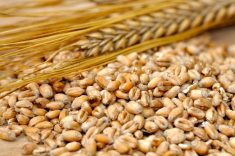There were no market reports last week due to the holiday season; however, I still received a few calls from cattle producers regarding the feeder market outlook for the first quarter of 2023. The feeder market finished 2022 at 52-week highs. Steers averaging 500 lbs. were readily trading over the psychological $300 level while 900-lb. yearlings were notching the board at $230.
Alberta packers were buying fed cattle on a dressed basis in the range of $306-$307 delivered. This equates to a live price of $184/cwt. Feedlot margins continue to hover in red ink on unhedged cattle but producers that forward contracted their cattle earlier in fall are in better shape. In this weekly comment, I will discuss a few factors that will influence the feeder market over the next three months. Usually, the feeder market trends lower during January and February but I’m expecting a counter-seasonal behaviour in the first quarter of 2023.
Read Also

U.S. livestock: Feeder cattle hit contract highs on tight supply
Chicago | Reuters – All Chicago Mercantile Exchange feeder cattle futures and most live cattle futures hit contract highs on…
Alberta and Saskatchewan feedlots have been back with market-ready supplies over the past three months. Alberta fed cattle basis has been historically weak. Carcass weights reached a high in November but were decreasing in December. This trend will likely continue through January and February. Feedlots will become more current and Alberta fed cattle basis levels will improve moving forward. Feedlots appear to have profitable margins booked later in the first quarter. U.S. first- and second-quarter beef production is expected to be down over five and seven per cent respectively compared to last year. This should enhance demand for Alberta fed cattle south of the border and support the yearling market in the first quarter.
March feeder cattle futures have been trading near $185 while the October contract made contract highs last week above $207. Unlike past years, there is a carrying charge in the market between January and the fall of 2023. The U.S. Department of Agriculture will release its Jan. 1 inventory report at the end of the month and expectations are for another year-over-year decline in the calf crop. The feeder market has been discouraging production since 2019. During the summer and fall of 2023, the feeder market will function to encourage expansion. I’m expecting 850-lb. steers to reach up to the $260-$270 level during August in central Alberta. Grass cattle will be extremely precious this spring and I would not be surprised to see 500- to 600-lb. steers tack on an additional $20-$30/cwt come March.
U.S. corn and Canadian barley fundamentals are extremely tight. The lower ending stocks for the 2022-23 crop year come on the heels of unprecedented geopolitical events. The coarse grain complex needs to encourage acreage this spring. There will likely be further upside in the barley and corn during April and May. Once it looks like the crop is made, barley and corn prices could trade to three-year lows during the fall.
The stars appear to be aligning for the feeder market. A sharp year-over-year decline in beef production along with lower feed grain prices should push the feeder market to historical highs by December 2023.
— Jerry Klassen is president and founder of Resilient Capital, specializing in proprietary commodity futures trading and market analysis. Jerry consults with feedlots on risk management and writes a weekly cattle market commentary. He can be reached at 204-504-8339 or via his website at ResilCapital.com.















